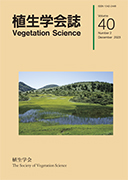
- 2 号 p. 21-
- 1 号 p. 1-
- |<
- <
- 1
- >
- >|
-
米林 仲2023 年 40 巻 2 号 p. 21-31
発行日: 2023年
公開日: 2024/01/19
ジャーナル フリーThe aim of this study was to reconstruct millennium-scale changes in mire vegetation. Local components determined by plot-based pollen and vegetation analysis represent the positions of local plants and the mire margin. The components allowed reconstruction of the changes in the local vegetation and the areal extent of a montane oligotrophic mire, Mae-yachi Mire, in 915 CE. The mire was drier and species such as Vaccinium oxycoccus, Andromeda polifolia, Sanguisorba tenuifolia and Sieversia pentapetala were more common. It has changed to a wetter one with abundant Sphagnum species. The extent of the mire has advanced more than 5 m, although the margin around the eastern end has been stable. The comparison between four mires in the same area showed that they had different vegetation histories during the last millennium. These empirical knowledges of the actual mire history provide the basic information for proper conservation procedures.
抄録全体を表示PDF形式でダウンロード (2221K)
-
石田 弘明2023 年 40 巻 2 号 p. 33-38
発行日: 2023年
公開日: 2024/01/19
ジャーナル フリーKuchinoerabujima Island is a volcanic island in Japan, with many areas covered by secondary evergreen broad-leaved forests dominated by Castanopsis sieboldii. The surface geology of these forests is mainly classified into the following two types:(1) lava flow, where many exposed rocks are found;and (2) tephra deposit, where no exposed rocks exist. I examined the species composition and richness of vascular plants growing on exposed rocks in the secondary evergreen broad-leaved forests on the lava flow of the island. In total, 54 species were observed on the 64 exposed rocks. Comparison of life-form spectra of the species composition revealed that relatively large exposed rocks were characterized by the presence of tree and shrub species. The sample scores for the first axis obtained by the detrended correspondence analysis were significantly correlated with rock area. A highly positive correlation between the number of species and rock area was observed for all species, tree species, shrub species, and climbing plant species. These findings indicate that the species composition and richness are affected by rock area.
抄録全体を表示PDF形式でダウンロード (1780K)
- |<
- <
- 1
- >
- >|